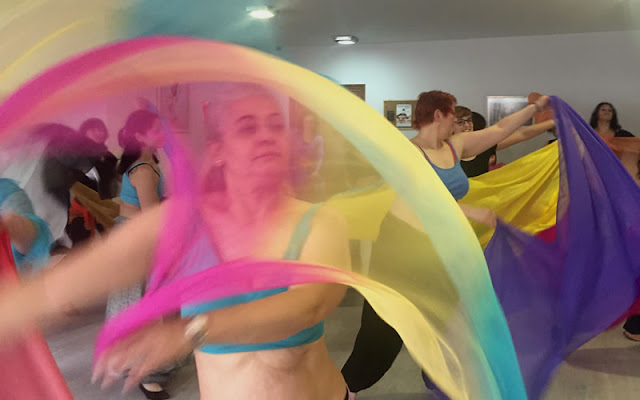Teaching Dance with Support for Participants with Autism, ADHD or Depression

“Adult praise, focused attention that communicates approval and positive regard … is an abundantly available natural resource that is (all too often) greatly underutilised.”
Walker, Ramsey, & Gresham
Dance
has the potential to support every learner in a variety of ways, including
people dealing with several common mental challenges that affect many nowadays, including Autism,
ADHD or depression. Unless asked, participants may be reluctant to share this
information with the instructor, so it is often left unspoken. In any dance class, the teacher may have participants living
with these circumstances, so it is important to be aware of, and understand more
about these conditions.
Teachers can benefit from having some awareness of Autism and by teaching with compassion. Knowing that a participant has Autism is helpful for the teacher, so together, student and teacher can build their relationship with this insight. For teachers, it is respectful to maintain the confidentiality of the student's specific condition, whether given verbally as part of an introductory chat or via a confidential section on the enrolment form.
Dance is temporal, happening in real time. Emotions and mental elements play a key role in the learning process, and with a clearer understanding of Autism, ADHD or depression, less misunderstanding will arise between the teacher and student. As body and mind are connected in dance, the participant’s sense of “integrated self” can indeed serve to support them as they move through life. Remember, they are already dealing with their own process, and these conditions, especially in the case of depression, are these states can be particularly difficult for one to live with. Yet dance can become a positive, supportive and strengthening force in their lives.
Teachers can benefit from having some awareness of Autism and by teaching with compassion. Knowing that a participant has Autism is helpful for the teacher, so together, student and teacher can build their relationship with this insight. For teachers, it is respectful to maintain the confidentiality of the student's specific condition, whether given verbally as part of an introductory chat or via a confidential section on the enrolment form.
Dance is temporal, happening in real time. Emotions and mental elements play a key role in the learning process, and with a clearer understanding of Autism, ADHD or depression, less misunderstanding will arise between the teacher and student. As body and mind are connected in dance, the participant’s sense of “integrated self” can indeed serve to support them as they move through life. Remember, they are already dealing with their own process, and these conditions, especially in the case of depression, are these states can be particularly difficult for one to live with. Yet dance can become a positive, supportive and strengthening force in their lives.
Autism
is one of the most rapidly expanding
categories of ‘disability’. It profoundly affects four areas of development:
language, socialisation, sensory, and motor skills. The term Autism Spectrum Disorders (ASD) is used to
indicate that there are different types and degrees of symptoms associated with
this disorder. Participants with ASD often have problems with attention and eye
contact and have significant problems interacting with others. Signs of Autism may show up
in movement patterns, such as rocking or fidgeting, or with repeating verbalisations or
activities.
Dance students with Autism often have a strong preference for routines but may have problems with transitions and directional movement. Subsequent behavior difficulties such as distress can result from confusion or anxiety. You can minimise these by providing well-structured dance activities with clear instruction and giving advance notice of transitions. It is also helpful to pre-frame the class content, and provide a program or schedule so participants know when activities are being scheduled. People with ASD are often visual-spatial learners, and it is important to support verbal instructions with imagery and modelling. Clear notes with images are also useful. Despite proficiency with language, participants with ASD may have difficulty in using and interpreting nonverbal behaviours, such as facial expressions and body language, as well as conventions such as taking turns to do movements in class, individually. As a teacher, you can support students to develop their understanding of nonverbal communication, and spatial movement by being clear in your own intentions, and verbalise rather than assume people are ‘reading’ your body language signals.
ADHD
or Attention-Deficit/Hyperactivity Disorder is
a common disabling condition that adversely affects learning. It is
characterised by inattention, hyperactivity or impulsivity. Participants may
have difficulty with following directions and may be easily distracted. Participants
with ADHD may have difficulty waiting and often blurt out answers or interrupt,
causing interpersonal problems within the class with those who are less
tolerant. Dance activities that emphasise body control, musicality and focusing
on changes between fast and slow, help support balance and foster a sense of self-control.
Depression
is distinguished from ordinary sadness
by the intensity and duration of symptoms. Psycho-physical complaints such as
frequent headaches and stomachaches, irritability, and restlessness are common
in adults who are depressed, or they may be lethargic, or have distressing
ideas that they dwell on. People who are depressed may sleep or eat too little
or too much, and are often withdrawn. Dance is a good way for people with
depression to ‘get out of their mind and back into their body’ so as a teacher,
encourage the student to move, but avoid pushing them to perform or do solos
where they may feel vulnerable. Allowing people to go at their own pace and
also letting people know that are free to leave at anytime, and will not be
judged, is a useful way of keeping the environment safe. I have found that a focus on musicality before technique is beneficial for students prone to depression, as is the study of Somatics - dancing that is felt from within.
Several core principles may assist the teacher with their relationship with their students dealing with Autism, ADHD or depression:
#1: Meet every student at their current level of learning, and move them toward achievement with realistic progress. Students with disabilities deserve the same high expectations for their own appropriate levels of achievement.
#2: Create a caring relationship
in a structured setting, with the
understanding that in our art form, there is a therapeutic aspect to our work. We
have the opportunity to reinforce positive behaviours, social interactions, and
help our students improve their self-image.
#3: Be aware of appropriate boundaries: over-involvement and ambiguous relationships are not helpful to students’ growth. It is important to maintain professionalism, especially when responding to challenging behaviour. Do not take students’ behaviour personally. Appropriate boundaries enable dance educators to be firm, fair, and respectful. Managing our students’ behaviour starts with managing ourselves.
#4:
Teach with clarity - articulate body parts,
shapes and actions. Utilise tools such as imagery and motif symbols to
represent and remember dance experiences. Descriptive language helps distinguish
between contrasting movements, both as performer and observer. By making connections
between dance concepts and the world outside the classroom, participants become
more deeply aware of personal space and its relation to safety and well-being.
"Most importantly... Mean what you say, say what you mean, but don't be mean!"





Comments
Post a Comment